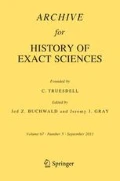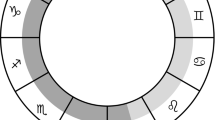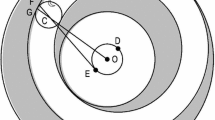Abstract
This paper is the third of a multi-part examination of the Babylonian mathematical lunar theories known as Systems A and B. Part I (Britton, AHES 61:83–145, 2007) addressed the development of the empirical elements needed to separate the effects of lunar and solar anomaly on the intervals between syzygies, accomplished in the construction of the System A lunar theory early in the fourth century B.C. Part II (Britton, AHES 63:357–431, 2009) examines the accomplishment of this separation by the construction of a successful theory depicting the variations due to lunar anomaly in System A and its subsequent adaptation in System B. The present paper examines the introduction of the uniform zodiac, necessary for any theory depicting variations depending on the position of syzygy. It addresses three questions: (1) In light of all available evidence, what is the magnitude of the constant term in the expression Δλ* = C − 1.3828°Y, describing the difference between the Babylonian sidereal longitudes and modern tropical longitudes? (2) What considerations governed the placement of the Babylonian sidereal zodiac relative to the fixed stars? (3) When was the uniform zodiac introduced? To the first question it finds C = 3.20° ± 0.1°, scarcely different from Huber’s (Centaurus 5:192–208, 1958) estimate of 3.08°, essentially confirming Huber’s result obtained from much less data. For the second it shows that accommodating the three asterisms comprising Taurus limited the placement of the zodiac to within 3°, while the prominence of half sign multiples among the measured intervals between prominent Normal Stars led irresistibly to the choice adopted. Finally, it finds that the zodiac was introduced between −408 and −397 and probably within a very few years of −400.
Similar content being viewed by others
Abbreviations
- ADART I–III:
-
A.J. Sachs and H. Hunger, Astronomical Diaries and Related Texts from Babylonia, Vol. I (–651 to –261), 1988; Vol. II (–260 to –164), 1989: Vol. III (–163 to end), 1995 (Vienna, Verlag d. Österreich. Akad. d. Wiss.)
- V:
-
H. Hunger, Astronomical Diaries and Related Texts from Babylonia:Lunar and Planetary Texts including materials by A.J.Sachs with an Appendix by J.M. Steele, Vol V, 2001 (Vienna, Verlag d. Österreich. Akad. d. Wiss.)
- AfO:
-
Archiv für Orientforschung, Verlag Ferdinand Berger & Sönne G.M.B.H.
- AHES:
-
Archive for History of the Exact Sciences, Springer-Verlag.
- Alm.:
-
Ptolemy’s ALMAGEST translated and annotated by G.J. Toomer (New York, Berlin, Heidelberg, Tokyo, 1984), Springer-Verlag.
- AOAT:
-
Alter Orient und Altes Testament, (Neukirchen-Vluyn), Verlag Butzon & Bercker Kevelaer
- D-nnn :
-
Diary for Julian year -nnn in ADART I–III
- H5, nn :
-
Text No. nn in ADART V
- HAMA:
-
O. Neugebauer, A History of Ancient Mathematical Astronomy (New York, Heidelberg, Berlin, 1975), Springer-Verlag.
- HdM::
-
P.J. Huber and S. de Meis, Babylonian Eclipse Observations from 750 BC to 1 BC,(2004), IsIAO–Mimesis
- JCS:
-
Journal of Cuneiform Studies(New Haven, Cambridge MA, Philadelphia, Ann Arbor)
- JHA:
-
Journal for the History of Astronomy, Science History Publications, UK
- RSW:
-
Roughton, Steele and Walker (2004)
- SH1:
-
ADART I
- UOS:
-
Under One Sky: Astronomy and Mathematics in the Ancient Near East J.M. Steele–A. Imhausen, eds., Papers delivered at a Symposium held at the British Museum 25–27 June, 2001, AOAT 297 (Münster, 2002) Ugarit-Verlag
References
Aaboe A., Britton J.P., Hendersen J.A., Neugebauer O., Sachs A.J. (1991) Saros cycle dates and related Babylonian astronomical texts. Transactions of the American Philosophical Society 81: 6
Aaboe A., Sachs A.J. (1969) Two lunar texts of the Achaemenid period from Babylon. Centaurus 14: 1–22
Britton, J.P. 1987. The structure and parameters of column Φ. In From ancient omens to statistical mechanics, ed. J.L. Berggren and B.R. Goldstein, 23–36. Copenhagen: University Library.
Britton J.P. (1989) An early function for eclipse magnitudes in Babylonian astronomy. Centaurus 32: 1–52
Britton J.P. (1990) A tale of two cycles: Remarks on column Φ. Centaurus 33: 57–69
Britton, J.P. 2002. Treatments of annual phenomena in cuneiform sources. UOS 21–78
Britton J.P. (2007) Studies in Babylonian lunar theory: Part I. Empirical elements for modeling lunar and solar anomalies. AHES 61: 83–145
Britton J.P. (2009) Studies in Babylonian lunar theory: Part II. Treatments of lunar anomaly. AHES 63: 357–431
Britton, J.P., and C.B.F. Walker. 1996. Astronomy and astrology in ancient Mesopotamia. In Astronomy before the telescope, ed. C.B.F. Walker, 42–67. London.
Brown. 2005. BM 53282 reconsidered (draft of an unpublished article dated Jan 13, 2005).
Gössmann, P.F. 1950. Planetarium Babylonicum, (Rome 2/4) Verlag des Päpstl. Bibelinstituts.
Huber P.J. (1958) Ueber den Nullpunkt der babylonischen Ekliptik. Centaurus 5: 192–208
Huber, P.J. 1982. Astronomical dating of Babylon I and Ur III, in collaboration with A. Sachs, M. Stol, R.M. Whiting, E. Leichty, C.B.F.Walker, and G. van Driel, Occasional papers on the near east 1.4. Malibu, CA: Undena.
Hunger, H. 1999. Planetenstellungen bei der Geburt. In Muniscula Mesopotamica, ed. B. Böck, E. Cancik–Kirshbaum, T. Richter, AOAT 267:229–239, Münster: Ugarit-Verlag.
Jones A. (2004) A study of Babylonian observations of planets near Normal Stars. AHES 58: 475–536
Kollerstrom, N. 2001. On the measurement of celestial longitude in antiguity. In Proceedings of the XXth International Congress of History of Science (Liège, 20–26 july 1997), Volume XII. Optics and astronomy, ed. G. Simon and S. Débarbat, 145–159. Turnhout: Brepols.
Moesgaard K.P. (1976) The bright stars of the zodiac, a catalogue for historical use. Centaurus 20: 129–158
Neugebauer, O. 1952. Exact sciences in antiquity. Princeton, NJ: Princeton Univ. Press (2 ed. Providence, RI: Brown Univ. Press, 1957).
Neugebauer O., Sachs A.J. (1967) Some atypical astronomical cuneiform texts. I. JCS 21: 183–218
Reade, J.E. 1986. Rassam’s Babylonian collection: The excavations and the archives. In Catalogue of the Babylonian tablets in the British Museum, Volume VI: Tablets from Sippar I, ed. E. Leichty, London: British Museum Publications.
Rehm, A. 1941. Parapegmastudien, Abh. d. Bayerische Akademie d. Wissenschaften, philos-hist. Abt., N.F. 19, Munich.
Rochberg, F. 1998. Babylonian horoscopes (Transactions of the American Philosophical Society, 88:1). Philadelphia: American Philosophical Society.
Rochberg F. (2004) Heavenly writing: Divination, horoscopy and astronomy in Mesopotamian culture. Cambridge, UK, Cambridge University Press
Roughton N.A., Steele J.M., Walker C.B.F. (2004) A late Bablyonian Normal and Ziqpu Star text. AHES 58: 537–572
Sachs A.J. (1952) A late Babylonian Star catalog. JCS 4: 146–150
Steele J.M (2000) Eclipse predictions in Mesopotamia. AHES 54: 421–454
Steele J.M., Gray J.M.K. (2007) A study of Babylonian observations involving the zodiac. JHA 38: 443–458
Toomer G (1968) Review of Die Anfänge der Astronomie by B.L. van der Waerden. The Journal of Hellenic Studies 88: 192–194
van der Waerden B.L. (1953) History of the Zodiac. AfO 16: 216–230
van der Waerden, B.L. 1965. Die Anfänge der Astronomie: Erwachende Wissenschaft II, (Groningen), P. Noordhoff.
Author information
Authors and Affiliations
Corresponding author
Additional information
Communicated by: Alexander Jones
This paper with Parts I, II and their sequels are dedicated to the memory of Asger Aaboe, who securely laid the foundations of a deeper understanding of Babylonian lunar theory and introduced me to these studies. Much of the relevant research was conducted while I was a Senior Fellow at the Dibner Institute, and I am indebted to both the Dibner Institute and Dibner Fund for their generous support. I should also like to thank Alexander Jones and John Steele for their careful reading and helpful comments and suggestions. Naturally, all remaining errors are my own.
John P. Britton—deceased.
Rights and permissions
About this article
Cite this article
Britton, J.P. Studies in Babylonian lunar theory: part III. The introduction of the uniform zodiac. Arch. Hist. Exact Sci. 64, 617–663 (2010). https://doi.org/10.1007/s00407-010-0064-z
Received:
Published:
Issue Date:
DOI: https://doi.org/10.1007/s00407-010-0064-z




